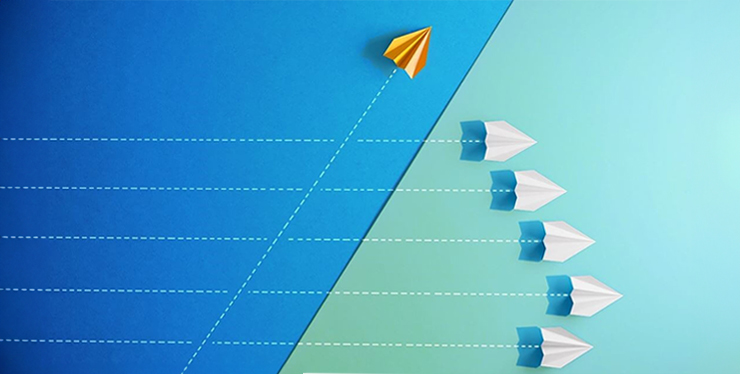
Not all problems are created equal
Problem solving is bridging the gap between where you are and where you want to be. It requires designing a strategy—which includes making decisions—and putting it into action.
This sounds easy. But problems come in all shapes and forms: some are obvious to pinpoint while others are hard to even identify. Some are simple while the complexity of others make them paralyzing. Some have insignificant outcomes while others have gargantuan stakes. This implies that not all problems deserve the same effort or the same approach. Here’s how to decide.
What kind of problem are you solving?
There are many ways to classify problems. One is to organize them by level of complexity:
- Simple problems: The easiest problems don’t have many variables—sometimes just one—and don’t involve much risk. How should I dress for a meeting with my client? Solving this problem shouldn’t require much analysis, and you can usually follow your intuition.
- Intermediate problems: Slightly more complex, intermediate problems might have several variables, yet you understand these variables and the importance of the decision isn’t terribly high. An example: figuring out where to take your family on your next vacation.
- Complex problems: Otherwise known as complex, ill-defined, non-immediate, and important (CIDNI) problems. Complex means that you might have various dynamic and interdependent variables. Ill-defined means that your initial conditions, final conditions, and the paths to a solution are unclear. An implication is that there usually isn’t one “right” answer—in fact, there may not be any solution at all … or various, each with different tradeoffs that speaks differently to various stakeholders, so the quality of the solution is subjective. Non-immediate and important means that you have some time—at least a few days, weeks, months, or even years—to identify and implement a solution. However, the stakes for your decision are high. Examples? Setting your company’s next two-year strategic plan. Deciding where to build that next plant. Reversing the effects of climate change.
There is more than one approach to problem solving
Once you know the kind of problem you’re facing, you can decide which method to use to solve it.
Here’s where differentiating between System 1 and System 2 thinking can provide valuable guidance.
In System 1 thinking, people don’t even realize they’re solving a problem. System 1 thinking is almost automatic and always quick. As a result, it doesn’t require a lot of effort. System 1 works best for solving simple problems.
Driving a familiar car on a familiar road is the type of simple problem that warrants System 1 thinking. Sure, you need to pay attention, but solving the problem isn’t overwhelming.
System 2 thinking, on the other hand, requires significantly more effort; you use a systematic approach to solving the problem. That translates to an investment of your time and other resources.
Even within System 2, you’ll find a gradation of problem-solving techniques. But, at its core, a System 2 approach to solving problems requires a three-step process:
- Frame: Summarize the problem in a single key question, for instance: “how should I do … ?”
- Explore: Outline the possible options for answering your key question.
- Decide: Identify what criteria matter so that you can rank the options you’ve identified. Weigh the criteria and evaluate the option that, overall, offers the best tradeoffs.
As problems become more challenging, we might need to adopt a more elaborate approach to resolve them. For instance, you might use a five-step approach to solve a CIDNI problem:
- Frame: As before, summarize the problem in a single key question.
- Diagnose: Before answering the key question, test your assumptions by asking why. This will give you further insights into your problem, which you can capture by reframing it into an updated key question.
- Explore: Outline the possible options for answering your key question.
- Decide: Identify your criteria, their importance, and which option offers the best tradeoffs overall.
- Convince: Determine how you’ll persuade your stakeholders—the key people on whom the success of your resolution process depends. These stakeholders are likely to have divergent interests and priorities. The success of your proposed solution and its implementation will depend on those.
Other resolution processes are more elaborate still, involving instruments such as scenario planning and probabilistic analysis.
Use an appropriate approach and effort for the problem you’re facing
A central element in improving your decision making is using an appropriate level of effort. Using too-shallow an analysis on a CIDNI problem—the so-called jumping to solutions approach—might lead to reaching a poor outcome, as you may make inappropriate assumptions, or you fail to account for the subtleties of your problem. Conversely, using a highly elaborate approach to solve simple problems will soon lead to paralysis by analysis, as the amount of research piles up with each new decision and you get overwhelmed with minutiae.
So, it is important to realize that one size doesn’t fit all, and that what matters depends less on your personal preferences as it does on the characteristics of your problem. You should use an approach that’s appropriate to the complexity of your problem.
Even then it is important to keep in mind what is ideal but also realistic. For CIDNI problems, more analysis isn’t necessarily better. We often meet executives who have access to tools to conduct scenario planning but don’t use them as they find them too intricate. Instead, some confess to resorting to the other extreme, solely trusting their intuition. As a result, they end up trusting gut far too much for problems whose complexity should warrant more structure.
Through guiding executives to improve their judgment in solving problems, we have found that a helpful approach is to think of your return on invested effort. For CIDNI problems, this creates a sweet spot that enables you to capture most of the benefits of an extremely detailed analysis without having to spend nearly as much energy. It also enables you to rely on tools that don’t require advanced quantitative training.
Stopping to determine what type of problem you’re solving will save you a considerable amount of grief down the line.
And if you’re facing a CIDNI problem, you’ll likely find the effort needed to frame and diagnose—an effort that might have seemed inefficient at first glance—will give you a stronger, more supported, and more successful solution. It will pay off in the long run.
Arnaud Chevallier is Professor of Strategy at IMD. Arnaud’s research, teaching, and consulting on strategic thinking bridges disciplines to provide concrete tools to improve critical thinking and corporate problem solving.
Albrecht Enders is Professor of Strategy and Innovation and Dean of Programs and Innovation at IMD. His major research, teaching and consulting interests are in the areas of managing discontinuous change and top team strategy development processes.
Research Information & Knowledge Hub for additional information on IMD publications
The case study delves into strategic transformation and leadership transitions at Unilever since 2009. Unilever has been an industry leader of busi...
The case study examines recent aviation safety concerns at Boeing, focusing on manufacturing issues, leadership decisions and regulatory oversight....
The case is seen through the eyes of the newly appointed supply chain director at a cosmetics company based in Berlin. The general manager has task...
Few Business to Business (B2B) marketplaces have succeeded. Metalshub has successfully combined a software platform as a service, with a marketplac...
The case focuses on Contabilizei, a Brazilian startup providing online accounting services for small and medium-sized enterprises (SMEs). The case ...

Companies that modularize and externalize their best capabilities are in a strong position to seize unexpected opportunities. Prediction is hard. T...
Research Information & Knowledge Hub for additional information on IMD publications
Research Information & Knowledge Hub for additional information on IMD publications
in I by IMD 24 June 2024
Research Information & Knowledge Hub for additional information on IMD publications
Research Information & Knowledge Hub for additional information on IMD publications
Research Information & Knowledge Hub for additional information on IMD publications
Case reference: IMD-7-2457 ©2024
Research Information & Knowledge Hub for additional information on IMD publications
Case reference: IMD-7-2546 ©2024
Research Information & Knowledge Hub for additional information on IMD publications
Research Information & Knowledge Hub for additional information on IMD publications
in MIT Sloan Management Review Summer 2024, vol. 65, no. 4
Research Information & Knowledge Hub for additional information on IMD publications
Research Information & Knowledge Hub for additional information on IMD publications




